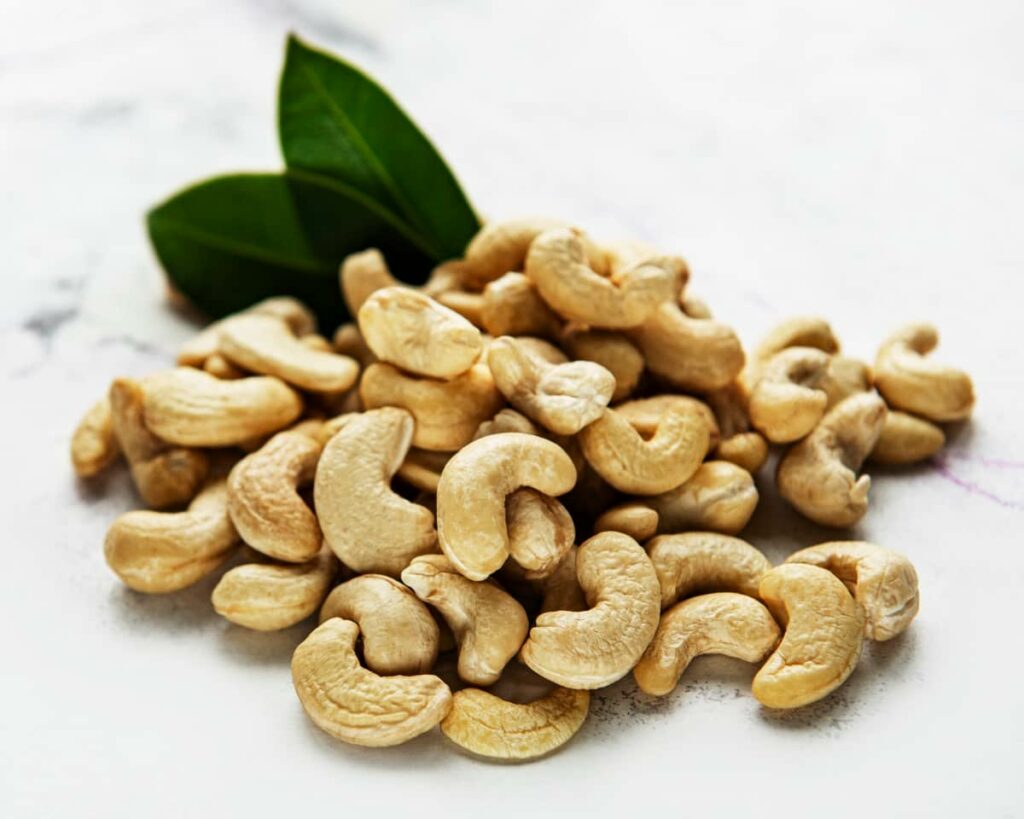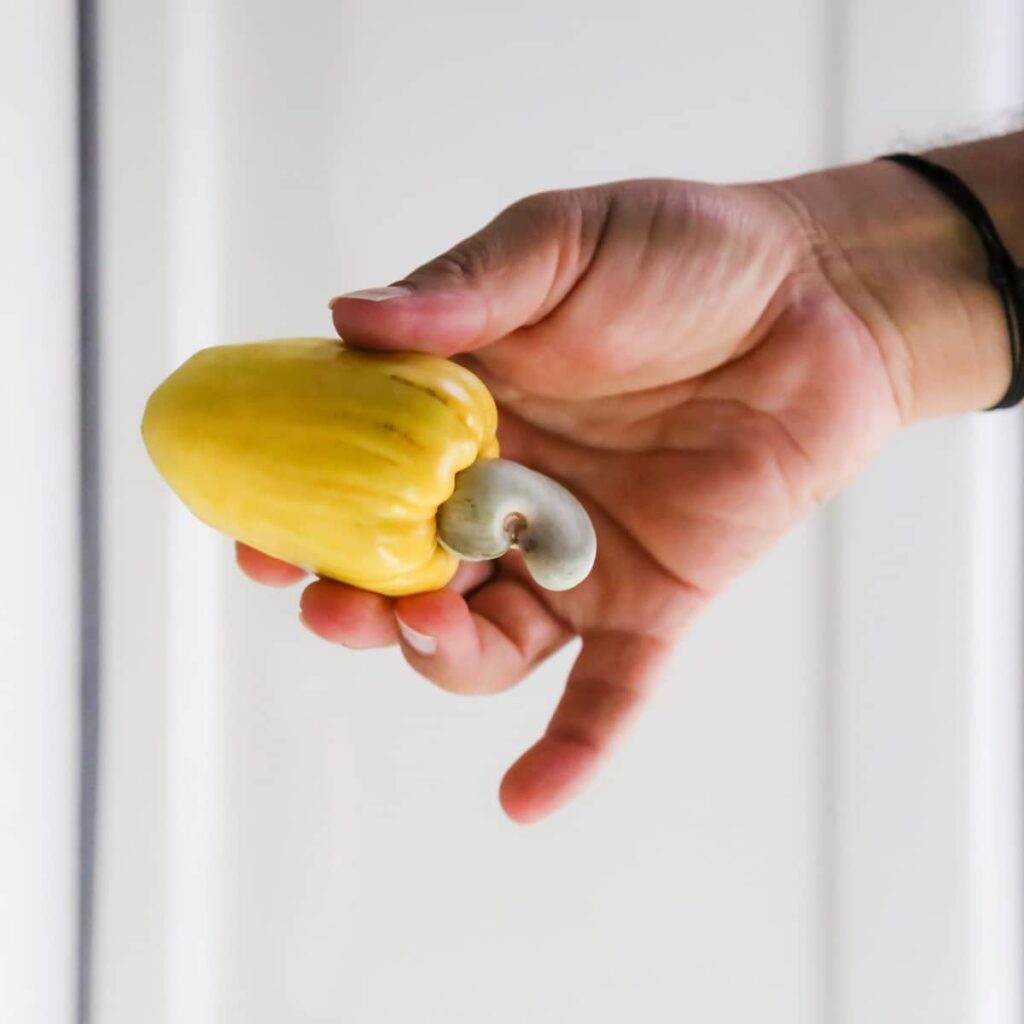Welcome to our blog post on Cashew Orchard Operations: Month-by-Month Guide to Cashew Orchard Management! Whether you’re an experienced cashew farmer or just starting, this comprehensive guide will provide valuable insights on effectively managing your cashew orchard throughout the year. Get ready to start on a journey that combines simplicity and engagement as we break down the intricacies of cashew cultivation in a compelling and easy-to-understand manner.

Optimizing Cashew Orchard Management
What is Cashew Farming and its Overview?
Cashew farming, originating from Brazil and introduced to India in the 16th century, initially served to combat soil erosion. Over time, it has become a significant foreign exchange earner, ranking just below tea and coffee. Cashew nuts are prominent among various nuts worldwide and are a popular snack, especially in Western countries. Cashew cultivation is primarily carried out in eight coastal states of India, namely Andhra Pradesh, Goa, Karnataka, Kerala, Maharashtra, Orissa, Tamil Nadu, and West Bengal.
Additionally, it is grown in select regions of Assam, Chhattisgarh, Gujarat, Meghalaya, Nagaland, and Tripura. India boasts approximately 9.53 lakh hectares of cashew orchards, yielding around 6.74 lakh tonnes of raw cashew nuts annually. As the third largest producer and exporter of cashew globally, India holds a pivotal position in the industry, trailing only Vietnam and Nigeria. Cashew farming significantly impacts the livelihoods of small and marginal farmers, particularly those residing along the coastal areas.
Approximately 2.00 lakh women workers are employed in cashew processing factories, mainly in Kerala, Andhra Pradesh, and Maharashtra. Furthermore, nearly two million people are directly or indirectly involved in cashew cultivation, processing, and marketing. Due to its prevalence on small and marginal farms, cashew cultivation plays a crucial role in the development and well-being of these farmers, contributing to their economic growth and stability.
In case you missed it: Best Fertilizers for Raised Bed Garden: When and How to Apply

Importance of Month-Wise Planning for Cashew Orchard Operations
- Increased productivity: Month-wise planning helps ensure that all the necessary tasks are performed on time, leading to increased productivity.
- Reduced costs: Month-wise planning can help to identify and reduce unnecessary costs, such as water and fertilizer.
- Improved quality: Month-wise planning can help improve the cashew nuts’ quality by ensuring they are harvested at the right time of maturity and processed properly.
- Increased profitability: Month-wise planning can help to increase profitability by reducing costs and improving quality.
Best Package and Practices Tips for Cashew Orchard Operations
Soil: Cashew is adaptable to different soil conditions but performs best in deep, well-drained sandy loam soils without a hard pan. Avoid water stagnation, flooding, heavy clay soils with poor drainage, and soils with a pH above 8.0. Cashew thrives in slightly acidic pH soils like red sandy loam, lateritic soils, and coastal sands.
Climate: Cashew is a tropical plant that can withstand high temperatures but is sensitive to frost during the early stages. It thrives at altitudes below 700m, where temperatures do not fall below 20°C for extended periods. Ideal growing conditions include temperatures ranging from 20 to 30°C and annual precipitation between 1000-2000mm. However, temperatures above 36°C during flowering and fruiting may adversely affect fruit setting and retention. Excessive rainfall and high humidity during flowering can lead to flower/fruit drop and fungal diseases.
Planting Material: Cashew is primarily propagated vegetatively to ensure desirable traits. Air layering is successful but has lower survival rates and shorter lifespans than grafted plants. Epicotyl grafting and softwood grafting are recommended for higher success rates and establishment. Adequate planting material is produced through standardized techniques by organizations like ICAR to meet growing demand. Purchasing planting material from certified nurseries is essential, considering details like plant age, variety, and rootstock mentioned in the bill/receipt.
Land Preparation: Thorough plowing and leveling are necessary for agricultural lands, while jungle clearing and debris burning are required for forestlands. Terracing and soil trenches can help with moisture conservation. Land preparation should be completed before the onset of the monsoon season.
Layout: Cashew trees are typically planted with a spacing of 7 to 9 meters using the square system. High-density planting initially and thinning out later is recommended for higher returns. In sloping areas, triangular planting accommodates more plants without compromising growth. Planting along contours with cradle pits or trenches helps prevent soil erosion and conserve moisture.
Digging and Filling pits: Pits should be dug in advance, ranging from 60cm x 60cm x 60cm for normal soils to 1m x 1m x 1m for hard lateritic soils. Topsoil and subsoil should be kept separately and allowed to wither under the sun to facilitate termite and ant migration. Pits are filled with topsoil mixed with organic matter like farmyard or compost, poultry manure, and rock phosphate. Adding BHC (Benzene hexachloride) can help mitigate soil-borne diseases.
In case you missed it: Optimizing Sweet Orange Orchard Management: A Month-By-Month Operation Guide for Maximum Yield

Planting: Grafted plants from superior mother plants are usually planted at the onset of the monsoon. Providing stakes and temporary shade in certain conditions can reduce mortality rates and aid quicker establishment. Pot irrigation can be done during the initial stages if monsoon rains are inadequate.
Mulching: Mulching is essential since cashew is often planted on wastelands with low soil moisture. Black polyethylene, grass, weeds, or stones can be used for mulching, helping retain moisture and preventing soil-borne pests.
Manuring and Fertilization: Cashew cultivation generally requires limited application of manures and fertilizers. Adequate N:P: K ratio is crucial for better yields. Application of farmyard manure and recommended fertilizers should be made at the right time, preferably after heavy rains. Fertilizers can be applied in split doses during pre-monsoon and post-monsoon seasons.
Training and Pruning: Remove sprouts from the rootstock in the first year to ensure plant health and prevent nutrient competition. Shape the trees for 3-4 years by removing lower branches and water shoots. Maintain a single stem up to 0.75-1.0m from the ground level. Stake the plants properly to prevent lodging due to wind. After 4-5 years, detop the main stem to a height of 4-5m from the ground level. Regularly remove dried/ dead wood, criss-cross branches, and water shoots every 2-3 years. Conduct training and pruning in August – September and apply Bordeaux paste to the cut surfaces.
Top Working: Genetic transformation through top working can significantly boost cashew production. Behead trees to allow juvenile shoots to grow, then perform in-situ grafting using high-yielding scions. Ideal periods for beheading and grafting are November to March and February to June, respectively. Within two years, top-worked trees can develop a canopy of 3-4m in diameter and 5-6m in height, yielding 3-5kg nuts per tree in the first harvest.
Pests and Diseases: Major pests include tea mosquitoes, thrips, stem and root borers, and fruit and nut borers. Control tea mosquito with carbaryl, phosalone, or dimethoate sprays during flushing, early flowering, and fruit set. Control thrips with monocrotophos or carbaryl sprays. Stem and root borers are difficult to control once an infestation occurs, but preventive measures with BHC swabbing can help. Control fruit and nut borers with monocrotophos sprays during flowering and fruit set. Powdery mildew is the main disease, which can be controlled by dusting with 2% sulfur W.P.
In case you missed it: Optimizing Sapodilla/Sapota Orchard Management: A Month-by-Month Operation Guide for Maximum Yield

Harvesting and Yield: Cashew plants start bearing after three years and reach full bearing around the tenth year. Harvest mature nuts that have dropped to the ground from February to May. Dry the nuts in the sun for 2-3 days to reduce moisture levels. The yield can be increased to 4-5kg per tree with improved practices and 8-10kg per tree with elite planting material and agronomic practices.
Marketing and Processing: Marketing raw cashew is not a problem as the production is lower than the processing capacity. Raw cashew nuts fetch a price of Rs.65-70 per kg in the internal market. Processing involves preliminary cleaning, roasting, shelling and separation, drying, and peeling. Roasting methods include an open pan, earthenware, rotary cylinder, and hot oil bath. Manual shelling results in better kernel recovery. Grading is based on the number of kernels per pound, and packing is done using the Vita pack method.
January Month Cashew Orchard Operations Planning
- Pinch off flowers on grafted plants.
- Spray Endo sulphon @ 2ml/lt for the second time.
- Water plants regularly at 5-day intervals.
February Month Cashew Orchard Operations Planning
- Water plants regularly at 5-day intervals.
- Monitor plants for bark borer and stem borer. If found, inject Dichlorovas @ 10 ml. /lt. of water in the damaged holes and plug them with sticky soil.
- Apply Bordeaux Paste on the trunk up to 30 to 45 cm height to avoid termites and fungal diseases.
- Provide shade with palmary leaves to protect the plants from hot sunburn.
March Month Cashew Orchard Operations Planning
- Water plants regularly at 5-day intervals.
- Apply one basket of mulch material to control evapotranspiration losses and weed growth in basins.
April Month Cashew Orchard Operations Planning
- Ensure regular irrigation through drip or basin irrigation.
- Hoe and mulch the soil to keep it loose and friable.
- Dig a profile pit to test the soil suitability. Avoid soils with calcareous nodules, sheetrock, water logging, ill-drained soils, or Black Cotton (B.C.) soils.
- Collect soil samples from the profile pit and test the soil pH. Avoid soils with a pH below 6.0 or above 8.0.
- Avoid soils and irrigation water with an Electrical Conductivity (E.C.) above 1.0 dsm or exchangeable sodium above 15%.
- The subsurface water table should be below 2.5 Mts.
May Month Cashew Orchard Operations Planning
- Ensure regular irrigation at least once in 5 days or through basin irrigation.
- Plow the land two to three times to get fine tilth and level the land.
- Mark the alignment and pegs for pit digging at a spacing of 8×8 m (64 plants/acre) or 7×7 m (80 plants/acre).
- Depending on the soil depth, dig pits of size 60×60 cm or 45x45x45 cm.
- Keep the top 1.5-foot soil to the right side of the pit and the bottom 1.5-foot soil to the left side of the pit. Allow the pit to expose to the sun for at least two weeks before filling it. This will help to control soil-borne pests and diseases.
- Make arrangements for procuring plant material from reliable nurseries, preferably from government nurseries or nurseries recommended by the horticulture department.
In case you missed it: How to Grow Alfalfa Microgreens from Seed: A Step-by-Step Seed Germination Guide

June Month Cashew Orchard Operations Planning
- Fill the pits with soil mixed with 10 kgs of Farm Yard Manure (FYM) + 200gms Single Super Phospate + 1-2 kgs Neem Cake and 100 gm. Of 10% Follidol dust per pit.
- Fill the pits with the soil at least 6″ above the ground level so that it will be at the ground level at planting when the soil settles.
- Ensure thorn fencing or any thick growing live fence to control cattle trespassing.
- Give mark out for trench cutting and complete the trench cutting for drip installation.
- With the onset of the monsoon, farmers can sow intercrops.
- Apply 225 gms of urea, 150 gms single super phosphate, and 40 gms MOP at 30 to 45 cm from the main trunk in basins after excellent soaking rains.
- Till the empty spaces and plant Sunn-hemp or Cow-pea green manure.
July Month Cashew Orchard Operations Planning
- Procure plant material from selected nurseries.
- Ensure that the plant material is of good quality.
- Transport the plant material to the planting site.
- Keep the saplings near a water source and water them regularly.
- If there is any delay in receiving good rains, soak the pits by irrigation or running the drip system.
- Remove the polythene sheet from the graft union carefully and plant the sapling in the pit’s center without disturbing the earth ball around the root system.
- Ensure the graft union is 6 inches above the ground level after planting.
- Stake the plant with a strong support stick 3 to 4 feet long. Dip the bottom of the stick in black tar to avoid a termite attack.
- Water the plant immediately after planting.
- Irrigate the plants every 4 to 5 days during the first month and later at 8 to 10 days if there are no rains during the initial two years.
August Month Cashew Orchard Operations Planning
- Protect the new growth from leaf-eating caterpillars or beetle attacks by spraying Quinolphos or Endosulphon @ 2 ml./lt. of water at every 15 to 20 days intervals.
- Weeding should be done once a month during monsoon season to control weeds. Simultaneously the basins around the plant should be made to retain water.
- Plough the interspaces with a blade-harrow or cultivator to free the land weed.
- To avoid Evapo-transpiration losses, mulch the basins with paddy husk, straw, or ground nut shells. Mulching also helps in the control of weeds in the basins.
- Remove the side shoots which appear on the rootstock.
- Leaf spot diseases generally appear when heavy rains are received during Aug.-Sept. Control by spraying Copper Oxy Chloride (Blitox) @ three gm./lt. of water. If not controlled in time, twig drying (Dieback) will lead to plant death.
September Month Cashew Orchard Operations Planning
- If a termite attack is seen on the support stick, spray Chloropyriphos (TermexC) @ 5 ml./lt. Of water. To the stem and support stick. Also, drench the basins with the above chemical.
- Prune the side branches arising from the main trunk at ground level.
In case you missed it: Maximizing Profits with a Comprehensive Tulsi Farming Business Plan

October Month Cashew Orchard Operations Planning
- Fill any gaps in the orchard due to the death of plants by replanting.
- Remove any side shoots that appear on the rootstock.
- Plant new trees in high rainfall zones in October or November.
- Sow intercrops for the rabi season if no intercrops were planted in June or July.
November Month Cashew Orchard Operations Planning
- Work the soil in the basins and mulch with dry leaves or paddy straw to control evapo-transpiration losses and weed growth.
- Remove any side shoots that appear on the rootstock.
December Month Cashew Orchard Operations Planning
- Remove flower buds as soon as they appear on grafted plants.
- Spray monocrotophos (1.6 ml) or Prophenophos (1.0 ml) per liter of water to control leaf-webbers, thrips, and tea mosquitoes.
Conclusion
Cashew orchard operations require careful management throughout the year. This month-by-month guide ensures optimal results. From pruning and fertilizing in the early months to pest control and harvesting later, implementing these practices will maximize cashew yield and maintain orchard health.
- Broccoli Varieties: Choosing the Right Cultivars for Your Farm
- How to Raise Pigs in Your Own Backyard: A Comprehensive Guide
- Budget Friendly Sheep Shed Ideas: Cheap and Low-Cost Tips
- How Much Do Cattle Farmers Make: Revenue Streams in Cattle Farming
- Management Pests and Diseases in Your Cotton Field
- Sheep Farming Business Plan for Beginners
- Aquaponic Farming at Home: A Step-By-Step Guide
- Profitable Village Farming Business Ideas in 2024
- High-Yield Aquaculture: Fast-Growing Fish for Farming
- Effective Fish Pond Construction Techniques for Beginners
- Irrigation and Water Management in Pineapple Farming
- Blossom to Harvest: Mastering Flowering and Pollination in Papaya Farming
- Pig Fattening Essentials: From Selection to Sale for Beginners
- Raising Wagyu Cattle: A Complete Guide for Premium Beef Production
- Soil Types and Their Water Holding Capacity
- Optimizing Irrigation Schedules for Coconut Groves for Enhanced Yield
- Espresso Your Garden: Coffee Grounds for Healthier Acid-Loving Plants
- The Best Soil Mix for Snake Plants: How to Mix Your Own Snake Plant Soil
- Green Thumb Success: Expert Tips for Cultivating Greenhouse Beans All Year Round
- Bloom All Year Round: The Ultimate Guide to Indoor Hyacinth Care
- Eco-Friendly Gardening: How to Make Liquid Fertilizer from Kitchen Waste
- Ultimate Guide to Grow Anise in Pots: Explore Seed Propagation to Harvesting
- Guide to Raising Chester White Pigs: Discover Breed Facts to Growth Management
- Mastering the Elegance: The Ultimate Guide to Weeping Cherry Tree Care, Planting, and Maintenance
- Ultimate Guide to Planting Garlic in Grow Bags: Growing Strategies for Beginners
- How to Fix Spider Plant Leaf-Related Problems: Natural and Organic Remedies
- 10 Reasons Why Your Tulsi Plant is Shedding Leaves: Home Remedies and Solutions
- Optimizing Growth and Yield: The Advantages of Palm Bunch Ash Fertilizer
- Utilizing Neem Oil Extract as a Natural Pesticide for Hydrangea
- From Soil to Harvest: Various Ways in Which Farmers Can Use AI Tools
- Steps to Encourage and Induce Citrus Flowers: A Comprehensive Guide
- How to Fix Snake Plant Leaf-Related Issues: Natural and Organic Remedies
- Transform Your Garden into a Fragrant Oasis with Raat Ki Rani (Night Blooming Jasmine)
- Discover the Ideal Chicken Breeds for Philippine Farms
- How to Create a Poultry Egg Farm Business Plan for Profits
- Grow Lemon Cucumbers Like a Pro: Insider Techniques for Bountiful Yields
